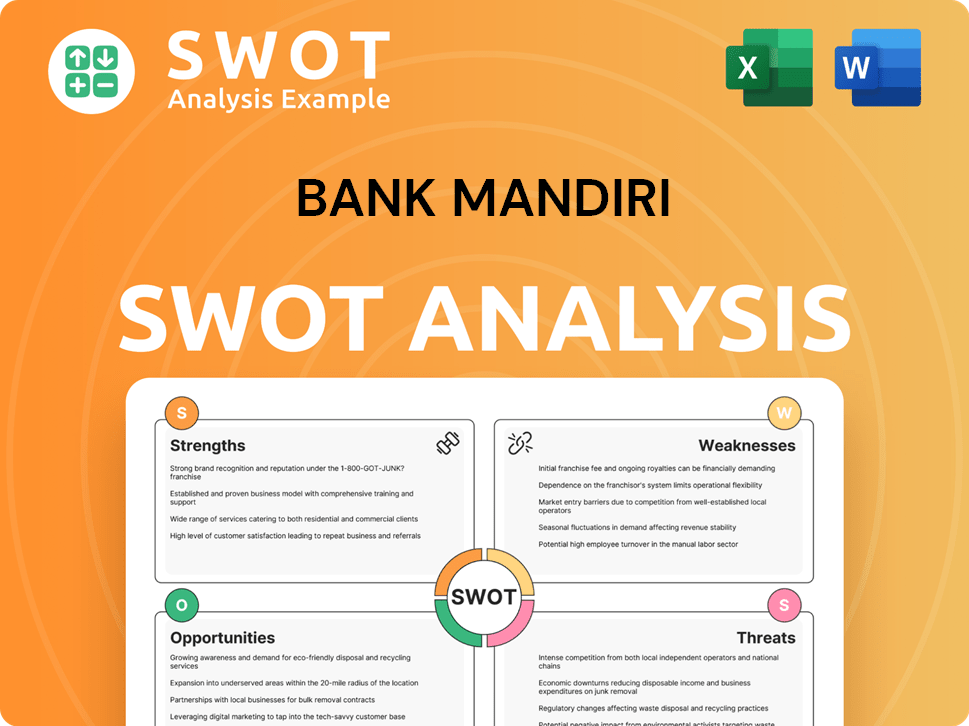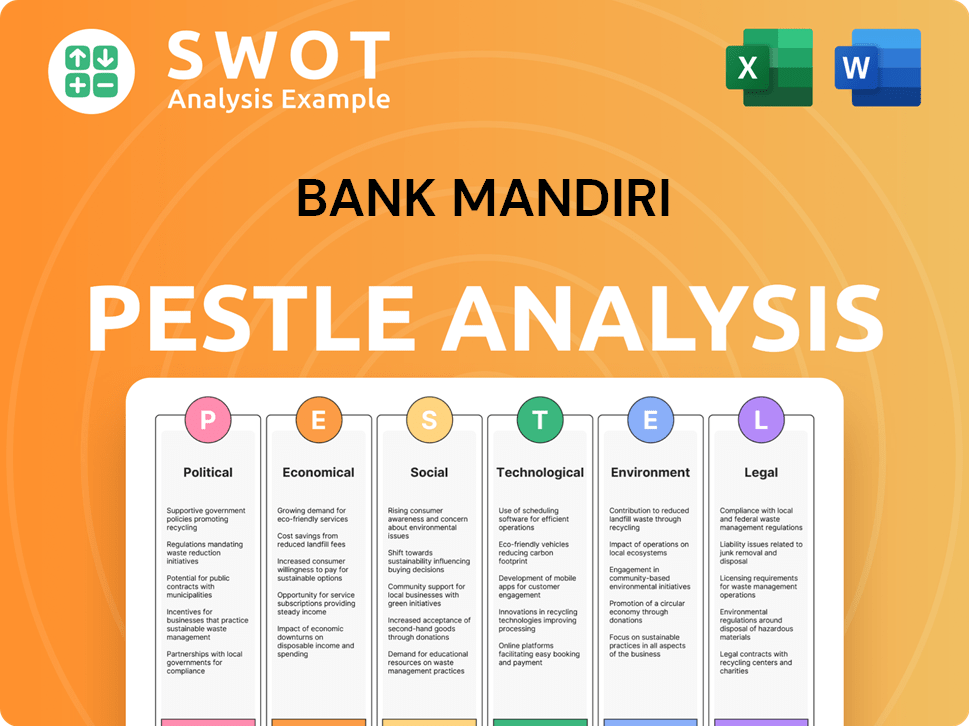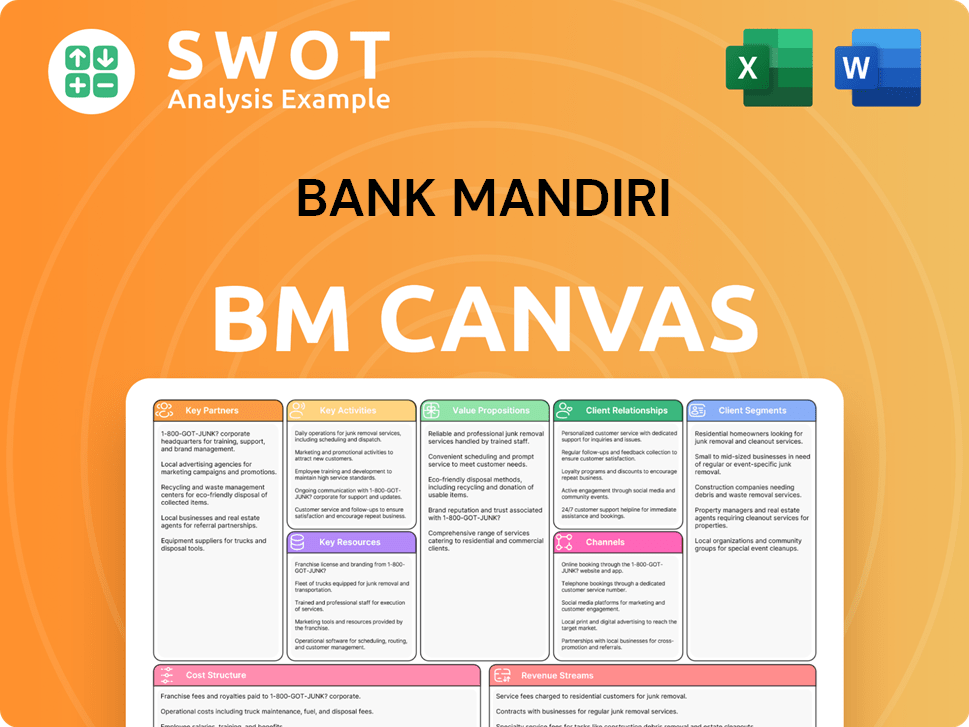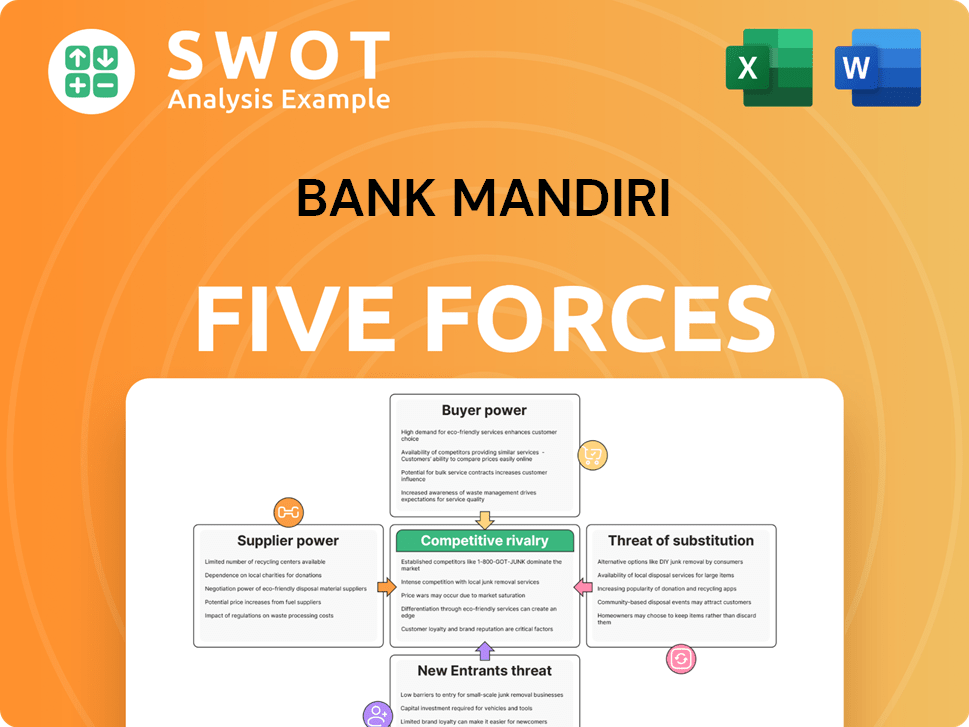Bank Mandiri Bundle
Can Bank Mandiri Continue Its Ascent in the Indonesian Banking Sector?
Bank Mandiri's journey from a post-crisis merger to Indonesia's banking behemoth is a testament to strategic foresight. Its aggressive adoption of digital banking and fintech integration has fundamentally reshaped its growth trajectory. This article explores the Bank Mandiri SWOT Analysis, delving into the bank's strategic initiatives and future prospects.

Understanding the Bank Mandiri Growth Strategy is crucial for investors and analysts alike. We'll examine the Bank Mandiri Future Prospects, considering its Bank Mandiri Company Analysis, including financial performance and strategic plans. This includes an in-depth look at how Bank Mandiri plans to expand its market share, navigate the challenges, and capitalize on the opportunities within the Indonesian Banking Sector.
How Is Bank Mandiri Expanding Its Reach?
Bank Mandiri is focusing on several key expansion initiatives to strengthen its market position and diversify its revenue streams. A significant part of this strategy involves the expansion of its digital banking ecosystem. This is primarily achieved through the Livin' by Mandiri app, which aims to attract more users and increase transaction volumes. This digital push is crucial for reaching a broader customer base, especially the younger, tech-savvy demographic and those in remote areas.
Geographically, Bank Mandiri is concentrating on strengthening its presence within Indonesia, particularly in high-growth regions and underserved markets. This is being done by optimizing its branch network and ATM distribution. The bank is also keen on enhancing its wholesale banking capabilities, especially in the corporate and commercial segments, by offering tailored financial solutions and advisory services. This includes a focus on supply chain financing and expanding its trade finance offerings.
Mergers and acquisitions remain a potential avenue for inorganic growth, though recent public statements from Bank Mandiri have not indicated specific large-scale M&A targets for 2024-2025. Instead, the bank appears to be prioritizing organic growth through digital transformation and strategic partnerships. For instance, collaborations with fintech companies and e-commerce platforms are vital for expanding its payment ecosystem and reaching new customer segments. These partnerships allow Bank Mandiri to integrate its financial services seamlessly into various digital consumer touchpoints, thereby increasing its transaction base and customer engagement.
The Livin' by Mandiri app is central to Bank Mandiri's digital expansion strategy. By the end of 2023, the app had reached 24.4 million users, with transaction values totaling Rp 3,271 trillion. This growth highlights the effectiveness of digital channels in attracting and retaining customers. This also aligns with the overall Marketing Strategy of Bank Mandiri.
Bank Mandiri is strategically optimizing its branch network and ATM distribution. While specific branch openings for 2024-2025 are not always explicitly stated, the focus is on digital penetration as a cost-effective and scalable expansion method. This approach allows the bank to reach a wider audience more efficiently.
The bank is enhancing its wholesale banking capabilities, particularly in the corporate and commercial segments. This includes offering tailored financial solutions and advisory services. A key focus is on supply chain financing and expanding trade finance offerings to support business clients.
Collaborations with fintech companies and e-commerce platforms are vital for expanding its payment ecosystem. These partnerships enable Bank Mandiri to integrate its financial services seamlessly into various digital consumer touchpoints. This increases its transaction base and customer engagement.
Bank Mandiri's expansion strategy is multifaceted, emphasizing digital transformation, geographic reach, and strategic partnerships. These initiatives aim to enhance the bank's financial performance and strengthen its position in the Indonesian banking sector. The bank is focusing on organic growth through digital transformation and strategic partnerships.
- Digital Banking: Expanding the Livin' by Mandiri app and enhancing digital services.
- Geographic Expansion: Optimizing branch networks and ATM distribution.
- Wholesale Banking: Developing tailored financial solutions for corporate clients.
- Strategic Partnerships: Collaborating with fintechs and e-commerce platforms.
Bank Mandiri SWOT Analysis
- Complete SWOT Breakdown
- Fully Customizable
- Editable in Excel & Word
- Professional Formatting
- Investor-Ready Format

How Does Bank Mandiri Invest in Innovation?
The growth strategy of Bank Mandiri is heavily reliant on innovation and technology, especially in digital transformation. The company has invested heavily in its digital platforms, with the Livin' by Mandiri mobile application at the forefront of its retail digital banking strategy. This focus is crucial for the Bank Mandiri future prospects.
Bank Mandiri's commitment to technology is evident in its adoption of AI and machine learning for data analytics, fraud detection, and personalized customer services. This is part of the Bank Mandiri strategic plan. The bank also uses automation to improve internal operations and customer experience.
Furthermore, Bank Mandiri is actively exploring sustainability initiatives through technology, including green financing products and ESG metric monitoring. This approach extends to its wholesale banking segment, developing digital solutions for corporate clients. Understanding the competitive landscape is also important, as discussed in Competitors Landscape of Bank Mandiri.
Bank Mandiri has significantly increased its investments in digital platforms, particularly the Livin' by Mandiri app. These investments are a key component of the Bank Mandiri growth strategy in digital banking. The bank's focus on technology aims to create a seamless banking experience.
The Livin' by Mandiri app has seen continuous enhancements, adding features such as Livin' Sukha. This integration of lifestyle services goes beyond traditional banking. Users can purchase airline tickets, make e-commerce payments, and invest in mutual funds directly from the app.
Bank Mandiri leverages AI and machine learning for various purposes, including data analytics and fraud detection. These technologies also help in providing personalized customer services. This is a key aspect of the Bank Mandiri's investment in fintech.
Automation plays a crucial role in streamlining internal operations and improving efficiency. This leads to enhanced customer experiences. Automation is part of the Bank Mandiri's digital transformation journey.
Bank Mandiri is actively involved in sustainability initiatives through technology. This includes developing green financing products and using technology to monitor ESG metrics. These initiatives are part of Bank Mandiri's sustainability initiatives.
The bank is developing advanced digital solutions for corporate clients in its wholesale banking segment. These solutions facilitate more efficient transactions and financial management. This is key to the Bank Mandiri financial performance analysis 2024.
Bank Mandiri's technological strategies focus on creating an integrated and secure banking experience. This approach is designed to attract new customers and deepen relationships with existing ones. This strategy is crucial for how Bank Mandiri plans to expand its market share.
- Digital Banking: The Livin' by Mandiri app is the cornerstone of the bank's retail digital banking strategy.
- AI and ML: Used for data analytics, fraud detection, and personalized customer services.
- Automation: Implemented to streamline internal processes and improve customer experience.
- Sustainability: Developing green financing products and monitoring ESG metrics through technology.
Bank Mandiri PESTLE Analysis
- Covers All 6 PESTLE Categories
- No Research Needed – Save Hours of Work
- Built by Experts, Trusted by Consultants
- Instant Download, Ready to Use
- 100% Editable, Fully Customizable

What Is Bank Mandiri’s Growth Forecast?
Bank Mandiri's financial outlook for the coming years is robust, supported by strategic initiatives and Indonesia's positive economic environment. The bank's performance in 2023 demonstrated strong growth, driven by effective lending strategies and robust demand across various sectors. This positive trajectory is expected to continue, with the bank focusing on sustainable profitability and expanding its customer base.
The Bank Mandiri Growth Strategy is centered on maintaining healthy loan growth and optimizing operational efficiency. The bank plans to invest heavily in technology and digital infrastructure to support innovation and expand its digital ecosystem. These investments are crucial for enhancing customer experience and driving operational efficiencies, which are key components of the bank's long-term financial goals.
For 2024, Bank Mandiri anticipates sustaining a healthy loan growth trajectory, with projections around 13-15% year-on-year. This growth will be supported by continued expansion in the corporate and retail segments, particularly through its digital channels. The bank's focus on digital transformation is a key element of its strategy to enhance customer experience and operational efficiency.
In 2023, Bank Mandiri reported a significant net profit of Rp 55.1 trillion, marking a 33.7% year-on-year increase. This strong performance was driven by healthy loan growth, improved asset quality, and efficient operational management. The bank's consolidated loan growth reached 16.2% year-on-year in 2023.
For 2024, Bank Mandiri projects loan growth of approximately 13-15% year-on-year. This growth is expected to be supported by continued expansion in the corporate and retail segments, particularly through its digital channels. This expansion is part of the bank's strategy to increase market share.
Bank Mandiri's strong capital position is highlighted by its capital adequacy ratio (CAR), which stood at 23.3% as of December 2023. This robust CAR provides ample capacity for future growth and strategic investments. This strong capital base supports the bank's expansion plans.
The bank's asset quality has improved, with the non-performing loan (NPL) ratio at a manageable 1.3% as of December 2023. This reflects effective risk management and contributes to the bank's financial stability. Effective risk management is a key factor in maintaining a low NPL ratio.
The Bank Mandiri Future Prospects are promising, with the bank aiming to solidify its position as a leading financial institution in Southeast Asia. This includes sustainable profitability and a growing customer base across diverse segments. The bank's strategic investments in technology and targeted lending are expected to drive sustained earnings growth. For more insights into the bank's target market, read about the Target Market of Bank Mandiri.
Bank Mandiri is heavily investing in digital infrastructure to enhance customer experience and operational efficiency. This includes expanding its digital ecosystem and leveraging technology to drive innovation. The bank's digital transformation is a key driver of its Bank Mandiri Strategic Plan.
The bank plans to expand its market share by focusing on both corporate and retail segments. This expansion includes strategic initiatives to increase its customer base and enhance its presence in key markets. The bank's growth strategy focuses on sustainable expansion.
Bank Mandiri is committed to maintaining strong asset quality through effective risk management practices. This includes monitoring and managing its loan portfolio to ensure a low non-performing loan (NPL) ratio. Effective risk management is crucial for the bank's financial stability.
The bank is focused on sustainability initiatives to ensure long-term profitability and contribute to the Indonesian economy. This includes integrating environmental, social, and governance (ESG) factors into its operations. These initiatives support the bank's long-term growth.
Bank Mandiri's competitive advantages include its strong capital base, efficient operational management, and robust digital infrastructure. These advantages enable the bank to compete effectively in the Indonesian Banking Sector. The bank leverages these strengths to drive growth.
The long-term financial goals of Bank Mandiri include solidifying its position as a leading financial institution in Southeast Asia, driven by sustainable profitability and a growing customer base. The bank aims for sustained earnings growth through strategic investments. These goals guide the bank's Financial Performance Bank Mandiri.
Bank Mandiri Business Model Canvas
- Complete 9-Block Business Model Canvas
- Effortlessly Communicate Your Business Strategy
- Investor-Ready BMC Format
- 100% Editable and Customizable
- Clear and Structured Layout

What Risks Could Slow Bank Mandiri’s Growth?
The growth strategy of Bank Mandiri faces several potential risks and obstacles. The Indonesian banking sector is highly competitive, with both traditional banks and fintech companies vying for market share. Furthermore, the rapid advancement of financial technology poses a constant need for innovation and investment.
Regulatory changes, both domestic and international, can significantly impact Bank Mandiri's operations and profitability. Geopolitical uncertainties and global economic slowdowns could also affect loan demand and asset quality. Cybersecurity threats are a persistent concern, especially with the bank's increasing reliance on digital platforms.
Bank Mandiri mitigates these risks through a comprehensive risk management framework. This includes robust internal controls, scenario planning, and stress testing. The bank also diversifies its loan portfolio to minimize concentration risk and invests heavily in cybersecurity measures.
The Indonesian banking sector is highly competitive, with numerous players vying for market share. Competition comes from both established banks and rapidly growing fintech companies. This necessitates continuous innovation and strategic adaptation to maintain a competitive edge.
Rapid advancements in financial technology pose a significant risk of disruption. Bank Mandiri must continuously invest in research and development to stay ahead. This includes enhancing digital platforms like Livin' by Mandiri and integrating new technologies to improve customer experience and operational efficiency.
Changes in banking regulations, both domestically and internationally, can impact Bank Mandiri. Shifts in interest rate policies, capital requirements, and digital banking regulations require strategic adjustments. The bank must proactively adapt to maintain compliance and operational efficiency.
Geopolitical uncertainties and global economic slowdowns can affect loan demand and asset quality. These factors may lead to an increase in non-performing loans. Bank Mandiri must implement robust risk management practices to mitigate these impacts.
Cybersecurity threats represent a persistent risk, given the bank's increasing reliance on digital platforms. Data breaches or system failures could erode customer trust and incur substantial financial losses. Bank Mandiri must continuously invest in cybersecurity measures and enhance its digital security infrastructure.
Bank Mandiri mitigates these risks through a comprehensive risk management framework. This includes robust internal controls, scenario planning, and stress testing. The bank diversifies its loan portfolio across various sectors to minimize concentration risk and ensures strong asset quality.
Bank Mandiri's strategic plan includes continuous investment in digital platforms, such as Livin' by Mandiri, to enhance security features and adapt to emerging threats. The bank maintains strong relationships with regulators to stay informed about impending changes and adapt its strategies accordingly. The bank's focus on Mission, Vision & Core Values of Bank Mandiri helps to guide its strategic decisions and operational practices.
Bank Mandiri's consistent profitability and strong asset quality metrics demonstrate its resilience in navigating various economic and market challenges. Emerging risks include the increasing sophistication of cyberattacks and the need to balance rapid digital expansion with robust risk controls. In 2024, the bank's focus remains on maintaining strong financial performance and adapting to the evolving landscape.
Bank Mandiri Porter's Five Forces Analysis
- Covers All 5 Competitive Forces in Detail
- Structured for Consultants, Students, and Founders
- 100% Editable in Microsoft Word & Excel
- Instant Digital Download – Use Immediately
- Compatible with Mac & PC – Fully Unlocked

Related Blogs
- What are Mission Vision & Core Values of Bank Mandiri Company?
- What is Competitive Landscape of Bank Mandiri Company?
- How Does Bank Mandiri Company Work?
- What is Sales and Marketing Strategy of Bank Mandiri Company?
- What is Brief History of Bank Mandiri Company?
- Who Owns Bank Mandiri Company?
- What is Customer Demographics and Target Market of Bank Mandiri Company?
Disclaimer
All information, articles, and product details provided on this website are for general informational and educational purposes only. We do not claim any ownership over, nor do we intend to infringe upon, any trademarks, copyrights, logos, brand names, or other intellectual property mentioned or depicted on this site. Such intellectual property remains the property of its respective owners, and any references here are made solely for identification or informational purposes, without implying any affiliation, endorsement, or partnership.
We make no representations or warranties, express or implied, regarding the accuracy, completeness, or suitability of any content or products presented. Nothing on this website should be construed as legal, tax, investment, financial, medical, or other professional advice. In addition, no part of this site—including articles or product references—constitutes a solicitation, recommendation, endorsement, advertisement, or offer to buy or sell any securities, franchises, or other financial instruments, particularly in jurisdictions where such activity would be unlawful.
All content is of a general nature and may not address the specific circumstances of any individual or entity. It is not a substitute for professional advice or services. Any actions you take based on the information provided here are strictly at your own risk. You accept full responsibility for any decisions or outcomes arising from your use of this website and agree to release us from any liability in connection with your use of, or reliance upon, the content or products found herein.